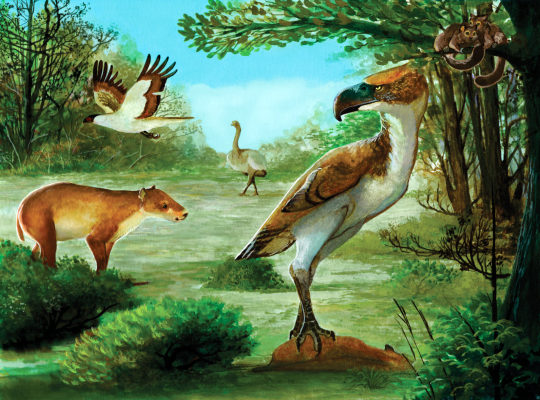#Antarctoboenus
Text
Fossil Novembirb: Day 8 - Raptors Are Back

Once the Cenozoic had begun, the only remaining dinosaurs were modern birds. That means raptors (or dromaeosaurs) would never again stalk the Earth, right? Wrong! Raptor dinosaurs get their name from modern raptors: eagles, hawks, owls and the like; and they are in fact some of the closest relatives of birds. So during the Paleogene period when predatory birds started to radiate, they weren't reinventing being a raptor. They continued being raptors.
Palaeoglaux: An early owl from Germany's Messel Lake, about 40 million years ago. Unlike modern owls, it had strange ribbon-like feathers on its body, likely used in display.
Horusornis: A strange relative of hawks and eagles that lived in France 35 million years ago. Like modern harrier-hawks, it had flexible feet to dig out prey from tree cavities.
Antarctoboenus: An early relative of falcons found from Antarctica, about 35 million years ago. It may have prowled near the edges of giant penguin colonies.
Danielsraptor: Another early falcon from the 50 million year old London Clay formation. It had a large jagged beak and long legs, which helped it catch prey on the ground.
Dynamopterus: A relative of Seriemas and terror birds from Messel lake, about 40 million years ago. It likely caught small vertebrates from the forest floor.
Paleopsilopterus: One of the earliest known terror birds, it lived in Brazil about 50 million years ago. It was already flightless and similar to later small terror birds.
Bathornis: A distant relative of terror birds that was remarkably successful. This flightless predator and its relatives lived in North America from the Late Eocene to the Oligocene.
Messelastur: A falcon-like bird of prey that was closely related to parrots and passerines instead of raptors. It lived in Messel Lake about 40 million years ago.
Masillaraptor: A tiny true falcon also known from Messel Lake. It had a relatively long beak from a falcon, and it may have fed mostly on large insects.
Tynskya: Another small raptor related to parrots and passerines, this falcon-like predator lived around 50 million years ago. Its remains have been found in North America and Europe.
#Fossil Novembirb#Novembirb#Dinovember#birblr#palaeoblr#Birds#Dinosaurs#Cenozoic Birds#Palaeoglaux#Horusornis#Antarctoboenus#Danielsraptor#Dynamopterus#Paleopsilopterus#Bathornis#Messelastur#Masillaraptor#Tynskya
76 notes
·
View notes
Text
Gli uccelli terricoli giganti erano i predatori principali dell'Antartide del periodo eocenico
Ricostruzione paleoambientale delle comunità continentali del primo Eocene di Seymour Island: un grande uccello cariamiforme che caccia un ungulato di medie dimensioni e fissa Notiolofos regueroi, una coppia di marsupiali su un albero, Antarctoboenus carlinii che vola sul cielo e un Ratites senza volo sul retro.
I paleontologi hanno portato alla luce due falangi fossili di un antico uccello…

View On WordPress
0 notes
Text
Giant Terror Birds Were Apex Predators of Eocene-Period Antarctica
Paleontologists have unearthed two fossilized phalanges of an ancient carnivorous bird on Seymour Island, Antarctica.
Paleoenvironmental reconstruction of the Early Eocene continental communities of Seymour Island: a large cariamiform bird hunting a medium-sized ungulate and staring at Notiolofos regueroi, a couple of marsupials on a tree, Antarctoboenus carlinii flying on the sky, and a…

View On WordPress
0 notes
Text
Giant Terror Birds Were Apex Predators of Eocene-Period Antarctica
New Post has been published on https://petn.ws/PWlUm
Giant Terror Birds Were Apex Predators of Eocene-Period Antarctica
Paleontologists have unearthed two fossilized phalanges of an ancient carnivorous bird on Seymour Island, Antarctica. Paleoenvironmental reconstruction of the Early Eocene continental communities of Seymour Island: a large cariamiform bird hunting a medium-sized ungulate and staring at Notiolofos regueroi, a couple of marsupials on a tree, Antarctoboenus carlinii flying on the sky, and a flightless […]
See full article at https://petn.ws/PWlUm
#BirdNews
0 notes
Note
Was Antarctoboenus the Haast Eagle of Eocene Antarctica?
It is only known from part of a foot, so there’s not much that can be said about its ecology. What is there is comparable in size to a modern caracara, a far cry from the giant Haast’s eagle.
1 note
·
View note